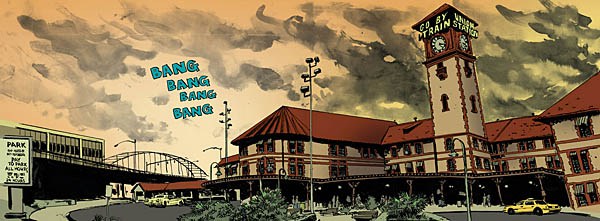My first introduction to Greg Rucka’s writing was in the Batwoman reboot. I lapped it up, being a huge fan of the Batman mythology and also a big fan of strong women. I looked more and more into Rucka, and found that this was a common theme of his. So of course when I saw the cover of Lazarus issue one – the dark, furious woman with a bullethole in her head, I was intrigued. The second issue drew me in further, showing Forever strolling down a desert highway toward the viewer with gun raised and sword drawn behind her. She looks like a less-sexualised Lara Croft: wearing sensible black military clothes, utility belt and pony tail flying in the wind, she’s certainly attractive but more importantly she’s athletic. Going through the pages, it’s clear that Forever has been modelled after athletes, with an appropriate body to match. But we’ll get to that later.
The first issue has just a few words which explain the state of the world. In the future, all power is related to wealth and the few “Families” who own that wealth rule the citizens they deem useful to them; anyone without a registered allegiance is considered Waste, and left to fend for themselves. Each family has a Lazarus, a member of the Family who has been given all the scientific and medical advances possible in order to protect the interests of that Family. In an interview, Rucka described the Lazarus as the “bloody sword and iron shield of the Family”, and explained that the Lazarus is not immortal, just capable of recovering from injuries no ordinary human could thanks to a level of science nearly indistinguishable from magic. This isn’t a spoiler by the way, as the first few pages show a clinical examination of Forever dying from serious wounds.
The attack is narrated in a medical and forensic way, detailing each wound and its effect. It becomes apparent when her eyes open and she goes after the men; this whole scene has a cold blue feel but when she finds the men and uses her superior fighting skills and strength, their deaths are highlighted in a backgroundless pink/purple hue that feels something like a film effect where a person’s life is drained out of them. Back in the sterile green doctor’s office, she confides in him that she feels bad about killing the men as they only wanted food. Already we get into the class issues of the comic, and Forever’s internal struggle to be okay with what everyone else in her Family believes it right. The doctor betrays her confidence immediately, contacting her brother Jonah and warning him that she needs to feel some positive reinforcement – that somebody loves her. He unwillingly agrees.
The concept is interesting already. Unlike many dystopian futures told by the rebel or the underdog, Forever is one of the elite. More than that, she’s a product of the elite, charged with protecting everything her Family deem important but in some ways more human than them. There are clear differences between Forever and Jonah. She’s dressed entirely in military gear, he’s in a dark suit with his hair slicked back. She looks positively confused that he hugs her. He explains that there was a raid on the compound by one of the other families, the Morrays, and that it must have been an inside job. When Jonah calls in all of the staff who could have done it, he threatens to kill them all and their families if no one confesses; when someone does, she’s almost certain he isn’t guilty, but has to kill him anyway. Before she kills him, she tells him she’ll tell his daughter he loves her – he says that she knows, a little kicker about what love and family really are.
At the end of the first issue, she’s telling the doctor she feels fine. The father of the Carlyle Family, Malcom, has brought his children together to discuss the Morray matter. This is a great way to see the different elements of the Family: the coniving Jonah, who appears to be having an affair with his twin sister Joannah (very Game of Thrones), who is absent from the meeting, the calmer but more timid Stephen, and the older sister Beth who treats Forever like a test subject. The Father dismisses Forever as “The Lazarus” behind her back, but treats her like his favourite daughter when with her; it’s obvious he is manipulating her using affection.
While Malcom speaks to Forever, the rest of the siblings fight about her in the kitchen. It becomes obvious that she’s not Malcom’s real daughter, suggesting that she was created specially for the family, but Beth goes wild at the suggestion of Forever finding out, knowing that they might lose control of her. Malcom’s splitting the kids up again, and Forever is to accompany Jonah back to Los Angeles, his own domain. The scenes of them travelling to the city which has been wrecked by earthquake show the distinct contrast between these elites in their armoured car escort drinking champagne while some kind of slum unveils behind them. “No point wasting resources on Waste who can’t appreciate it”, comments her brother.

As she walks through the dystopian city, Jonah’s tail Mason stalks behind her, seemingly hidden. She approaches some playing children, hands them a note and walks around the corner; of course he runs after her, taking the note from the children but rounding the corner to find a dead end. He opens the paper: “If you keep following me, I’m going to kill you.” I certainly wouldn’t mess with her. The last we see of Forever is out in the desert preparing to talk to the Morray Family, but they surround her and take her prisoner. I absolutely cannot wait to see what happens next – Rucka’s commented that she and the Morray Lazarus will get on much better than you might think, and (this is just my speculation) maybe she’ll learn something about another Family’s ways which will help her to answer some of the questions her own aren’t prepared to deal with.
The character design of Forever is clearly detailed; she looks consistent panel to panel, and I don’t think we’ve seen her crack a smile once. As I mentioned earlier, they clearly put a lot of thought into how a woman would be created for such a purpose; very tall, muscular, a large ribcage to support athletic levels of breathing. And yeah, she is good-looking, but such a vain family wouldn’t have created an ugly member, and at least she’s not a cartwheeling blonde schoolgirl. When the project was first announced, she was named Endeavour, but while Forever has a similar meaning it can also be shortened to Eve, perhaps suggesting that she has the capability to change the world.
The dystopian future that Lazarus is set in was inspired by the economic environment of the world today and the Occupy movement, with the central concern being, what if things don’t get better? Like most good science fiction, it’s a social allegory, and Forever seems to represent the conflicting values of family pride/nationalism with genuine concern for other human beings. The colouring is subtle, usually consisting of pages bathed in a certain shade for different areas, and the facial expressions are exquisite, courtesy of Michael Lark. Interestingly, the mother of the Family is being kept back for now, and it really feels like Rucka and Lark are after a long run with Terminator Forever; their previous collaboration Gotham Central was a huge success for them both and they were critically acclaimed as a great partnership; with the relative freedom of Image Comics, I hope this partnership endures and we learn more about this horrible world and the heroine that you’re sure to care for by the end of the second issues.
Originally posted on the Travelling Man blog


